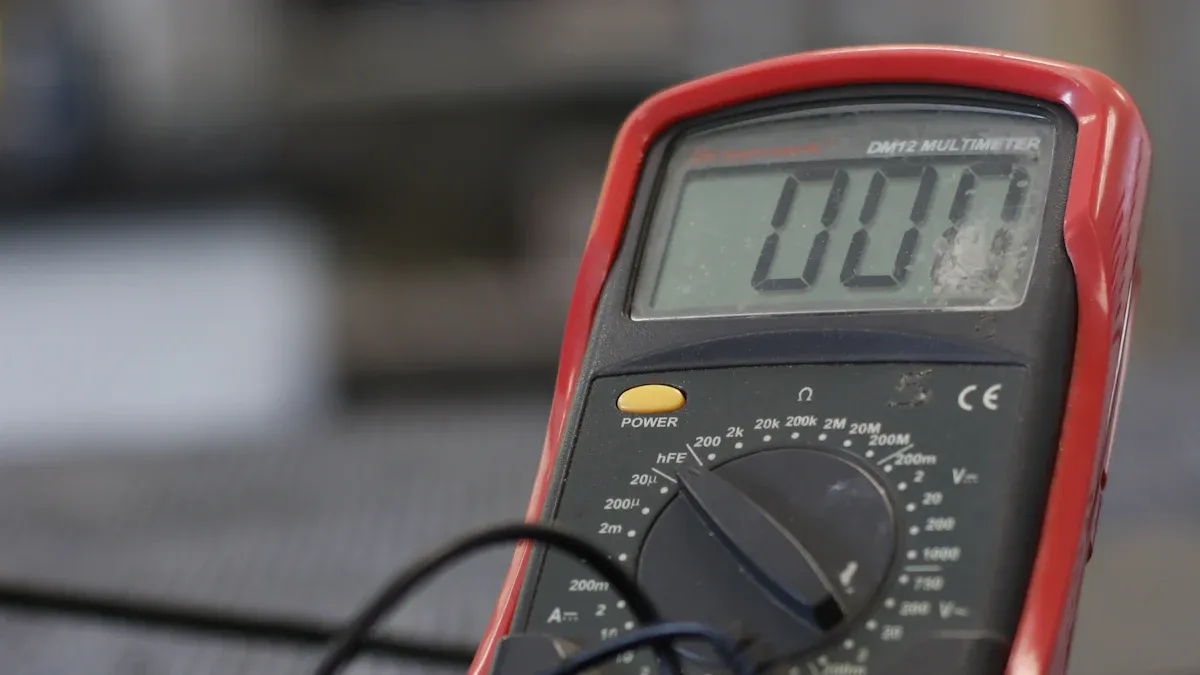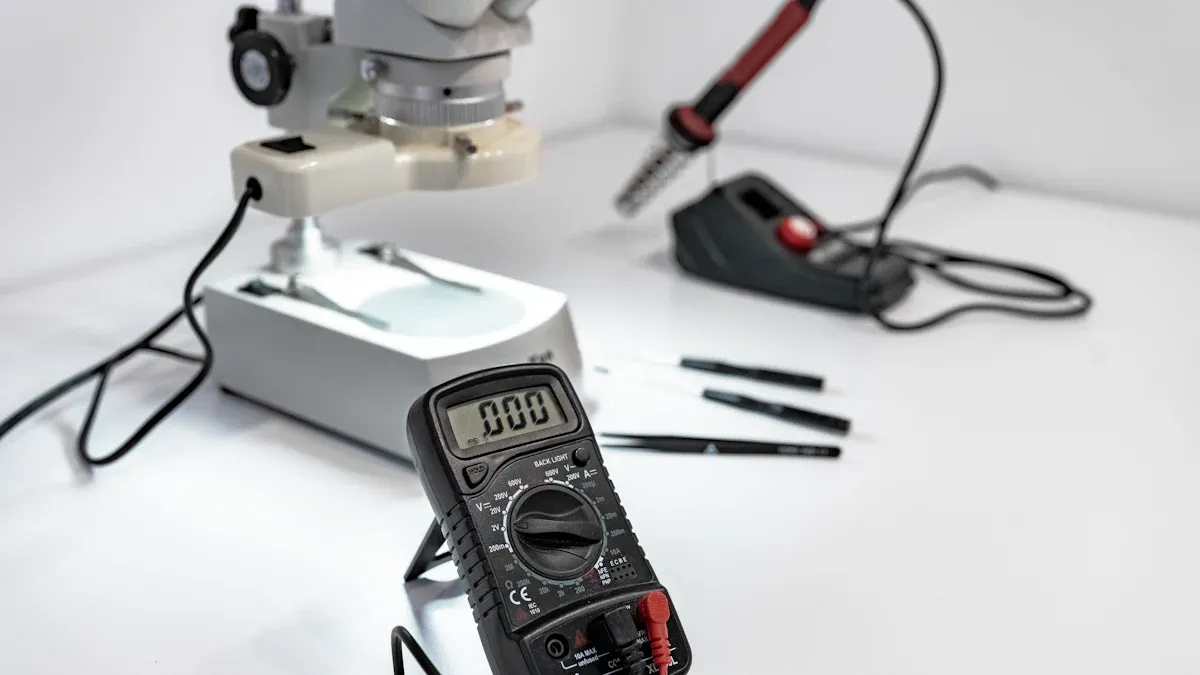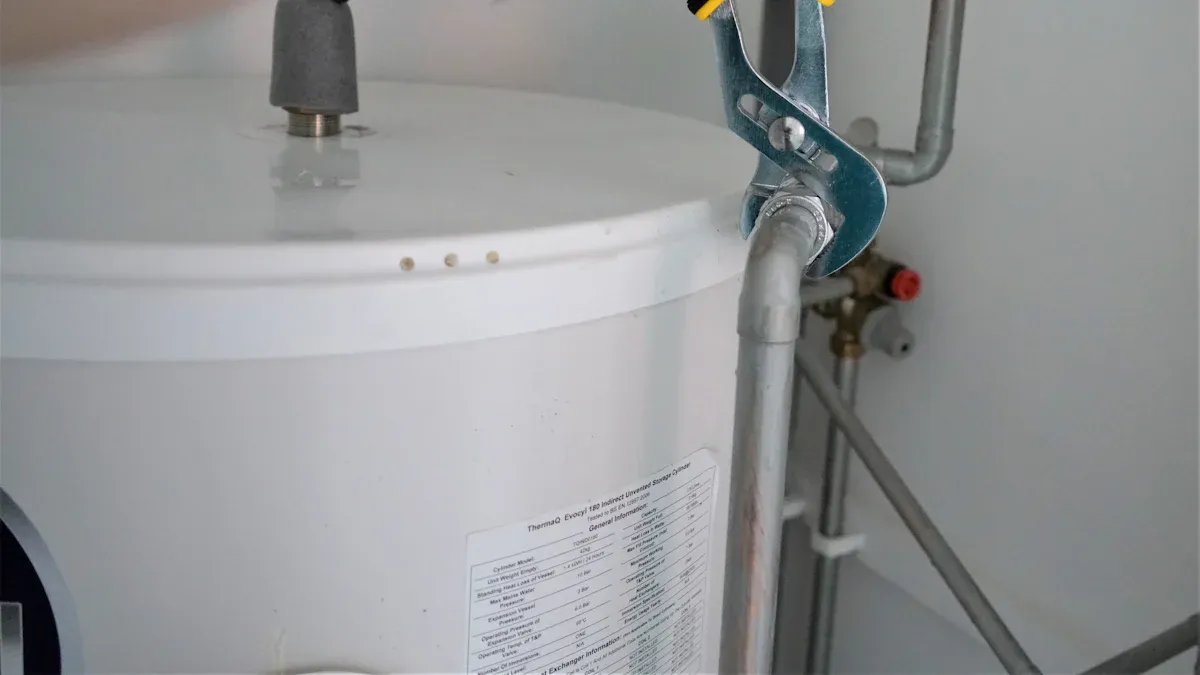
When your water heater stops producing hot water, you often face a faulty water heater element. You can perform testing at home to pinpoint the problem and restore efficiency. Many Elemento calefactor issues arise from wear and tear, especially in elementos calefactores de electrodomésticos. Reliable brands like Calefacción eléctrica Jinzhong supply components trusted by Fabricantes de elementos calefactores. With basic tools and safety steps, you can check your water heater element and resolve heating problems quickly.
Water Heater Not Heating: Common Causes
When your water heater stops working, you want to find the cause quickly. Several issues can prevent your unit from producing hot water. Plumbing professionals often report these common reasons:
- Problems with the thermostat
- Issues with heating elements
- Pilot light problems
- Acumulación de sedimentos
- Malfunctioning thermocouple
- Tripped circuit breaker
Failed Water Heater Element
Signs of Element Failure
You may notice several warning signs when the element in your water heater fails. Cold water from your taps is the most obvious clue. Sometimes, you get only lukewarm water, even after waiting for the tank to heat up. Inconsistent water temperature or a sudden drop in hot water supply also point to a faulty element. If your electric water heater trips the circuit breaker, this can signal a shorted element.
Consejo: If you hear popping or hissing noises from the tank, mineral buildup on the element may cause it to overheat and fail.
Why Elements Go Bad
Heating elements wear out over time. Mineral deposits from hard water can coat the element, causing it to overheat. Frequent cycling, power surges, or manufacturing defects can also shorten the lifespan of these parts. If you ignore regular maintenance, sediment can build up and insulate the element, making it work harder and eventually burn out.
Thermostat and Electrical Issues
Mal funcionamiento del termostato
A faulty thermostat can prevent your water heater from working properly. You might notice agua tibia o fría if the thermostat fails to turn on the heating element. Sometimes, a stuck thermostat causes the water to overheat, which can trigger safety shut-offs. Fluctuating water temperatures often indicate a malfunctioning thermostat.
Power Supply Problems
Electrical issues can also stop your water heater from heating. Loose wiring, corrosion, or a tripped circuit breaker can interrupt power to the unit. Electrical shorts or burnouts may damage internal components, leading to system failure. Always check the power supply before replacing parts.
Nota: Addressing electrical problems early can prevent more costly repairs down the road.
Safety Steps Before Testing Your Water Heater Element
Before you begin testing your water heater element, you must prioritize safety. Working with electrical appliances exposes you to risks, so you need to follow strict procedures to protect yourself and your home.
Cómo apagar el calentador de agua
Localización del disyuntor
You should start by identifying the correct circuit breaker for your water heater. Most electric water heaters connect to a dedicated breaker in your main electrical panel. Look for a label that matches your water heater or check your owner’s manual for guidance. If you cannot find a label, trace the wiring from your water heater to the panel. This step ensures you do not accidentally leave the unit powered while working.
Verificar que la energía esté apagada
After switching off the breaker, you must confirm that the power is truly off. Use a non-contact voltage tester or a multimeter to check the terminals on your water heater. Place the tester near the wires and look for any indication of voltage. If your tester shows no power, you can proceed. Never rely solely on flipping the breaker; always verify with a tool.
You should also keep these safety precautions in mind:
- Wear insulated work gloves to protect against sharp parts and debris.
- Work in a well-lit area and keep the workspace clear of clutter to minimize hazards.
- Never work on internal parts with wet hands; ensure the area is dry.
- Wear safety glasses when dealing with chemicals or debris.
Gathering Tools for Testing
Multimeter Selection
A multimeter is essential for measuring electrical resistance, voltage, and current. Choose a digital multimeter with a clear display and reliable probes. You need a model that can measure resistance in ohms, which is necessary for diagnosing your water heater element. If you have a non-contact voltage tester, use it for an extra layer of safety before you touch any wires.
Screwdriver and Safety Gear
You will need a screwdriver to remove the access panel and insulation from your water heater. Select a screwdriver that fits the screws on your unit to avoid stripping them. Electrical tape helps secure connections and prevents accidental contact with exposed wires. Personal protective equipment, such as insulated gloves and safety glasses, reduces the risk of injury from sharp edges or electrical shock.
| Herramienta | Propósito |
|---|---|
| Multímetro | Measures electrical voltage, resistance, and current. |
| Destornillador | Used for accessing the water heater components. |
| Cinta aislante | For securing connections and ensuring safety. |
| Comprobador de tensión sin contacto | Optional tool for added safety during testing. |
Safety is paramount when dealing with electrical components. You should ensure your workspace is clear of clutter to minimize hazards and wear personal protective equipment, including insulated gloves and eye protection, when working with electrical systems. These steps help you avoid accidents and allow you to focus on diagnosing issues, such as a faulty thermostat or heating element, with confidence.
Accessing the Water Heater Element
When you need to test or replace your water heater element, you must access it safely and efficiently. This process involves removing the access panel, handling insulation, and disconnecting the element’s wires. You should follow each step carefully to avoid injury and prevent damage to your water heater.
Extracción del panel de acceso
Unscrewing the Panel
Begin by locating the access panel on your water heater. Most electric models feature a metal panel secured with screws. Use a screwdriver that matches the screw heads to avoid stripping them. Remove each screw and set them aside in a safe place. You should keep track of all hardware to ensure a smooth reassembly.
Consejo: Place screws in a small container or magnetic tray to prevent losing them during the process.
Removing Insulation
After you remove the panel, you will see a layer of insulation covering the internal components. Gently pull back the insulation to expose the thermostat and heating element. If your water heater uses fiberglass insulation, wear gloves and safety glasses to protect your skin and eyes. Avoid tearing the insulation, as you will need to replace it after testing or repairs.
Locating and Disconnecting the Water Heater Element
Identifying Terminals and Wires
Once you have clear access, identify the heating element terminals. You will see two wires connected to screws or posts on the element. These wires supply power to the heating element. Examine the area for any signs of corrosion, discoloration, or loose connections. If you notice damage, you may need to replace the wires or terminals.
| Componente | Descripción |
|---|---|
| Elemento calefactor | Metal rod with two terminal screws |
| Termostato | Flat device near the element |
| Wires | Usually black and red or white |
Desconexión segura de cables
You must disconnect the wires before testing or replacing the element. Use a screwdriver to loosen the terminal screws. Gently pull the wires away from the element, taking care not to bend or damage them. Always confirm that the power is off with a voltage tester before touching any wires.
Follow these steps to ensure safety and prevent damage:
- Shut off the circuit breaker for electric heaters or turn off the gas valve for gas models.
- Confirm there is no live power using a voltage tester.
- Turn off the cold-water inlet valve and drain the tank until the water runs cool.
- Disconnect the electrical wires from the heating element terminals.
Nota: If your water heater is heavy or difficult to move, ask another person for help to prevent injury.
You should always work methodically and avoid rushing. Properly disconnecting the wires and draining the tank reduces the risk of electrical shock and scalding. Once you complete these steps, you are ready to test the resistance of your water heater element.
How to Test Water Heater Element Resistance

Testing the water heater element is a straightforward process when you use the right tools and follow each step carefully. You can diagnose heating elements in your water heater and determine if they need replacement. This section guides you through setting up your multimeter and measuring the resistance of the water heater element.
Configuración del multímetro
Choosing the Correct Resistance Setting
You must select the proper setting on your multimeter before you begin testing. Most digital multimeters feature a dial or button for selecting measurement types. To test heating elements, set your multimeter to the ohm (Ω) setting. This mode allows you to measure resistance, which is the key indicator of a functioning water heater element.
- Turn the multimeter dial to the ohm symbol (Ω).
- Confirm the display reads zero or shows a small value when the probes touch each other.
- Use the lowest resistance range available for the most accurate reading.
Consejo: A functioning water heater element should show a resistance between 10 and 30 ohms. For the upper heating element, a reading between 5 and 25 ohms indicates good condition.
Testing the Multimeter Function
Before you measure the resistance of heating elements, you should verify that your multimeter works correctly. Touch the two probes together and check the display. A properly functioning multimeter will show a reading close to zero, confirming the device is ready for testing.
If your multimeter does not respond, check the battery and probe connections. Replace the battery if needed and ensure the probes are securely attached. Reliable readings depend on a properly functioning multimeter.
Measuring Resistance on the Water Heater Element
Placing Probes on Terminals
You can now measure the resistance of the water heater element. Place one probe on each terminal screw of the element. Make sure you have disconnected the wires from the terminals and the power is off. Steady your hand to avoid slipping and ensure good contact between the probes and the metal screws.
Follow these steps to measure resistance:
- Power down your water heater at the circuit breaker.
- Access the heating elements by removing the metal covers and insulation.
- Disconnect the wires from each water heater element.
- Adjust your multimeter to the ohm setting.
- Place the probes on the heating element screws.
⚡ Alerta: Never attempt to test heating elements with the power on. Always confirm the electric water heater is disconnected from the power supply.
Recording the Resistance Value
After you place the probes on the terminals, read the value displayed on your multimeter. Write down the resistance value for each heating element. Compare your readings to the recommended range. If the resistance falls between 10 and 30 ohms, your water heater element is likely in good condition. Readings outside this range may indicate a faulty element.
| Element Location | Expected Resistance (Ohms) |
|---|---|
| Upper Element | 5 – 25 |
| Lower Element | 10 – 30 |
You should repeat the process for each heating element in your water heater. Accurate testing helps you identify which part needs replacement and ensures your water heater operates efficiently.
Interpreting Water Heater Element Resistance Readings
Normal Resistance Values for Water Heater Elements
Typical Ohm Ranges by Wattage
When you finish testing your water heater element, you need to compare your results to standard values. Most residential heating elements have a specific resistance range that signals proper function. You can use these typical values as a benchmark:
- Typical resistance values for standard residential water heater elements range from 10 to 30 ohms.
- The exact resistance depends on the wattage of the heating elements in your unit.
- A reading within this range usually means your water heater element is working as intended.
If your measurement falls outside this range, you may have a problem with your water heater.
What Low, Zero, or High Readings Mean
Understanding your resistance reading helps you pinpoint the issue. Here is what different readings can indicate:
- A resistance reading of zero means the element has burned out. This is called a short circuit, and you need to replace the element.
- Any reading above zero, but within the normal range, suggests the element is functioning properly.
- A very high reading, or one that does not register at all, points to a broken circuit inside the element. This means the heating elements cannot heat water and require replacement.
- A low or zero reading often signals a failed water heater element.
Consejo: Always use a multimeter to measure resistance across the element’s terminals for accurate results.
Diagnosing a Failed Water Heater Element
Signs of Burned or Damaged Elements
You can often spot a failed water heater element by observing your water heater’s performance and inspecting the element itself. Common signs include:
- Only cold water when you expect it to be hot.
- Hot water that runs out quickly.
- The red reset button on the top thermostat keeps turning off, which can indicate overheating.
- Uneven hot water supply, where hot water runs out faster than normal.
- Warm water even when the heater is set to maximum.
If you notice any of these symptoms, you should check the resistance of your heating elements.
When to Replace the Element
Visual inspection can confirm what your electrical testing suggests. Look for these issues:
| Inspection Criteria | Implicaciones |
|---|---|
| Cracks >0.5mm | Compromises safety; replace immediately. |
| Corrosion (pitting/rust) | Indicates electrolytic decay; potential failure. |
| Conexiones sueltas | Must be tightened to 12–15 Nm; affects performance. |
If you see cracks, corrosion, or loose connections, you should replace the water heater element. Even if your resistance reading seems normal, visible damage can lead to sudden failure. Always tighten any loose connections to the recommended torque for safe operation.
⚠️ Alerta: Never ignore visible damage or abnormal resistance readings. Replacing a faulty element restores your water heater’s performance and prevents further issues.
What to Do If the Water Heater Element Is Not the Problem
If you have tested the element and found it in good condition, you need to look at other possible causes for your water heater’s lack of hot water. The thermostat often becomes the next component to check. This device controls the temperature and ensures the heating element receives power when needed.
Comprobación del termostato del calentador de agua
How to Test the Thermostat
You can test the thermostat by following a systematic approach. Start by turning off the power to your water heater. Remove both access panels, insulation, and any plastic safety covers. Check if the reset button has tripped. Use a small screwdriver to set the upper thermostat temperature to the highest setting and the lower thermostat to the lowest. Restore power to the unit.
Next, check the two wires above the reset button to confirm voltage is present. Place your multimeter probes on the upper element contact screws. If you do not detect power at the element, you need to replace the thermostat. If you find power, adjust the upper thermostat to the lowest setting. You should hear a click as the thermostat turns off. Set the lower thermostat to the highest setting and check the lower element for voltage. If you detect power, allow the water to warm, then lower the thermostat temperature. Listen for another click. If you do not find power at the lower element, test the lower thermostat for voltage.
Consejo: Always ensure the power is off before removing panels or touching wires. This step prevents electrical shock.
Other Electrical Checks
If the thermostat works as expected, consider other electrical issues. A tripped circuit breaker can stop your water heater from working. Reset the breaker and check for signs of electrical overload. Inspect wiring connections for corrosion or looseness. For gas models, confirm the gas valve is open and the supply is steady. If you find any issues with the gas supply, you may need professional help.
Here is a quick checklist for troubleshooting beyond the thermostat:
- Check the thermostat for proper function.
- Reinicie cualquier disyuntor disparado.
- Inspect wiring for damage or corrosion.
- Confirm the gas valve is open (for gas models).
When to Call a Professional for Your Water Heater
Complex Electrical Issues
Some problems require expert attention. If you notice safety concerns such as gas leaks or electrical faults, do not attempt repairs yourself. These issues pose serious health risks. Extensive damage, such as visible leaks or water pooling around the unit, signals the need for professional evaluation. Attempting repairs in these situations can void your warranty and lead to greater expenses.
Professional Replacement Services
You should also contact a professional if you encounter persistent leaks, strange noises, rusty or discolored water, or inconsistent hot water. Rising energy bills can indicate hidden problems that only a trained technician can diagnose. Professionals have the tools and experience to handle complex repairs and ensure your water heater operates safely and efficiently.
⚠️ Alerta: DIY repairs can void your warranty and may not address underlying issues. Always consult a licensed technician for major repairs or if you feel unsure about any step.
Reemplazo de un elemento calentador de agua defectuoso

Choosing the Right Water Heater Element Replacement
Matching Wattage and Size
Selecting the correct replacement element ensures your water heater operates safely and efficiently. You need to match the wattage and voltage to your existing system. Most residential water heaters use 240-volt elements with wattages ranging from 1000 to 6000 watts. Smaller or point-of-use heaters often require 120-volt elements with lower wattages. Always check your water heater’s label or manual for the exact specifications.
| Voltaje | Rango de potencia | Uso común |
|---|---|---|
| 240 V | 1000 – 6000 watts | Most residential water heaters |
| 120 V | 1000 – 2500 watts | Smaller and point-of-use heaters |
You also need to confirm the socket size. Most elements fit a dado estándar de 1-1/2 pulgada, but always verify with your manufacturer’s instructions. The material of the element matters as well. Stainless steel, copper, and brass each offer different benefits depending on your water quality and environment. Stainless steel resists corrosion, while copper heats quickly but may not last as long in hard water.
Safety comes first when picking a water heater element. Certified elements meet strict safety standards. For example, a recall in 1978 showed that uncertified immersion heaters could cause deadly electric shocks.
Where to Purchase Elements
You can find replacement elements at hardware stores, plumbing supply shops, or online retailers. Bring your old element or note the model number to ensure compatibility. Look for products with safety certifications and a clear warranty. If you have unique requirements, consult your water heater’s manufacturer for approved parts.
Step-by-Step Water Heater Element Replacement
Quitar el elemento antiguo
Follow these steps to remove the faulty element:
- Turn off the power at the circuit breaker and verify with a multimeter.
- Shut off the water supply and allow the tank to cool.
- Drain the tank using a hose or bucket.
- Remove the access panel and insulation.
- Desconecte los cables de los terminales del elemento.
- Use a 1-1/2 inch socket or element wrench to unscrew the old element.
- Remove the rubber gasket if it is worn or damaged.
Tip: Allow the tank to cool completely before draining to avoid burns from hot water.
Instalación del nuevo elemento
Install the new element by hand-tightening it into place. Use a wrench to secure it, but avoid overtightening, which can crush the gasket and cause leaks. Reinstall the rubber gasket if needed. Reconnect the wires to the same terminals as before, ensuring a snug fit.
- Using the wrong tools can lead to leaks.
- Apretar demasiado puede aplastar la junta y provocar fugas.
- Las roscas cruzadas dañan las roscas, lo que también puede generar fugas.
Restoring Power and Testing
Close the drain valve and turn on the cold water intake to refill the tank. Check for leaks around the new element. Once the tank is full, restore power at the breaker. Wait for the water to heat, then test your hot water taps to confirm proper operation. If you notice any leaks or electrical issues, turn off the power and review your installation.
Always ensure the tank is completely full before restoring power. Running the element dry can cause immediate failure.
You can solve most heating issues by testing your water heater element. Always follow safety steps before you begin. If you find a faulty element, replacement costs much less than buying a new unit. Regular maintenance offers many benefits:
| Beneficio | Explicación |
|---|---|
| Improved Efficiency | Prevents sediment buildup for better performance |
| Vida útil prolongada | Early issue detection prolongs heater life |
| Reduced Risk of Costly Repairs | Fixing small problems saves money |
- Inspect your system yearly.
- Check more often if you notice changes in hot water supply.
PREGUNTAS FRECUENTES
¿Con qué frecuencia debes probar el elemento del calentador de agua?
You should test your water heater element once a year. Regular checks help you catch problems early and keep your system running efficiently.
Can you test a water heater element without removing it?
Yes, you can test the element without removing it. Disconnect the wires from the terminals and use a multimeter to check resistance directly on the installed element.
¿Qué herramientas necesitas para probar un elemento del calentador de agua?
You need a digital multimeter, a screwdriver, and safety gear like insulated gloves and safety glasses. A non-contact voltage tester adds extra safety.
What does a zero resistance reading mean?
A zero resistance reading means the element has shorted out. You need to replace the water heater element to restore proper function.
Can a water heater element fail without visible damage?
Yes, an element can fail internally without showing visible signs. Always use a multimeter to confirm the element’s condition.
¿Es seguro reemplazar un elemento del calentador de agua usted mismo?
You can replace a water heater element if you follow all safety steps. Always turn off power and water before starting. If you feel unsure, contact a professional.
What should you do if the new element does not heat water?
Consejo: Double-check all electrical connections and ensure the tank is full before restoring power. If the problem continues, test the thermostat or consult a licensed technician.


